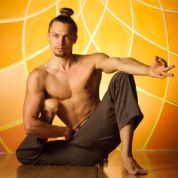Scott Blossom, a respected teacher from the San Fransisco Bay Area, is another fabulous teacher in this year’s Bhakti Fest 2011 line-up. He teaches in the Shadow Yoga lineage, is an Ayurvedic consultant, and a practitioner of Traditional Chinese Medicine. His practice is clearly deep and chatting with him makes me want to forget about vinyasa flow and yoga hype and go live in an ashram and dedicate my heart and soul to my practice. J/K…but almost. Enjoy his words of wisdom.
Ele: What are the roots of Shadow Yoga?
Scott: Shadow Yoga is a system created by my teacher, Zhander Remete. Ultimately, it’s a Hatha Yoga system with deep influence from South India and influence from Ayurvedic medicine. It uses a lot of spiraling and circular movements and a lot of low squatting dynamic lunging movements to open up the seat of prana. This is the groundwork to begin the more subtle practices which involve the seated postures, inversions, pranayama, mudra, all these things that require the yogi to have really good internal circulation of prana.
What makes it unique from other yoga systems?
The prelude forms reflect a deep integration of foundational work from South Indian martial arts and dance traditions. The movements are not mainstream yoga patterns. And also it emphasizes the Ayurvedic marma system, which are the vital points, so the yogi learns to circulate the life-force by understanding the subtle anatomy of the body from that perspective.
Any special plans for Bhakti Fest workshops?
I will be offering both Shadow Yoga classes and workshops related to Ayurvedic medicine. Since Bhakti Fest will merge Bhakti into Hatha Yoga, I will be referencing this Bhakti integration into all my teachings.
How do you feel about relating Kirtan to Hatha Yoga? What is the connection there?
In my own experience with singing and chanting, I think there’s something very natural about learning how to deepen your breathe through these practices. Sometimes I think it can be challenging for people to control their breathe, but while we’re singing, we are naturally lengthening the breathe without it being contrived or mentally oriented.
The other thing is that I think many people in America have gotten very far into their Hatha Yoga practices and developing their alignment in the poses, and then a situation arises where they say “Ok, I’m now technically a good Hatha Yoga practitioner, so what is the next step?” And the next step has everything to do with devotional qualities becoming more prominent for that person. And that’s the traditional way to do it…in Hatha Yoga, the techniques to practice mantras internally during the poses are reserved for a later stage in the practice and they are usually kept secret because the teacher will guide the students in an individual manner, mostly because its another whole layer that requires more subtle concentration and it brings up more potential for freeing up more flow of prana, tapping into a source of energy that is greater than an ego mindset or controlling mindset.
Where do you see American Yoga headed in terms of the progression of yoga practice? Anything we should be looking out for in the next step in our yoga community?
People are really yearning for community and the kirtan scene is creating a community that is heart-based and not overly intellectual, and in this world of technological connectivity, people are wanting the good old-fashioned heart-centered connectivity. It looks like a strong trend.
And on the other side of spectrum, I think that as yoga becomes more commodified and as people who seek financial gain as their primary mode of being are noticing big profit potentials in the yoga world…the proliferation of teacher trainings, clothing, mats, etc…branding yoga styles…in the old days when a teacher had a certain way of doing things and students resonated with that way of going about it, they gathered around that teacher and that is normal, but what is unusual is that there is so much money in it that you get people and ideas that are largely centered around profiting in a monetary sense…and I’m somewhat concerned because I didn’t come into it with that intention and I feel like it has created some compromises and hype that is going to produce unusual side-effects.
I feel that on one side there’s a very strong culture of people doing yoga purely for the love of yoga and there’s a very strong culture of people that are doing yoga for the love of money. And they are teaching for economic reasons before other reasons or starting yoga businesses…and this is a new phenomenon. But I know for myself that I am committed to preserving an integrity on what I am willing to sell and what I am not willing to sell.
How do we keep our American Yoga roots? How do we keep a balance between commercialism and the teachings?
I think those are subtle questions because I feel that American culture has a deep narrative that is in commercialism, so its going to be a difficult proposition to separate yoga from commercialism, but speaking for myself, when I teach students or train teachers, I tell them “What you learn from me, keep this for yourself, this is for you. And when you share it with others, two things are required. One is that you have really mastered the material well enough to make it nourishing for the students you are sharing it with. And number two, that it is important to have a part of your practice that is for yourself.” And that is where the heart of it is. For me, I work on things for at least three years before I share them and start bringing them into public so that I have time to really digest it.
I don’t teach in teacher’s trainings anymore because what I feel I really want to do is that if I have people that are to teach under me, it will be really obvious that I have karma with them and I can teach them the old way which is mentorship style, and it really promotes a community that is based around the Shadow Yoga teachings that I have to share, purely for the love of it, and I’ve been doing this for a few years now and I really appreciate the results and the quality of the students, the joy, the humor, the community, and the clean energy that is in the group.
What can we do to help the yoga community, boost it, help fulfill it?
The simple answer to that is to be really dedicated to our own practice and the unending well of new and beautiful energy that comes out of that space. And its infectious, so that people who are new to it will be able to recognize it in somebody who is deep into that space and be inspired by somebody who is able to find really deep, juicy energy in their personal practice.
Learn more about Scott and his teachings at ShunyataYoga.com.









Read 3 comments and reply